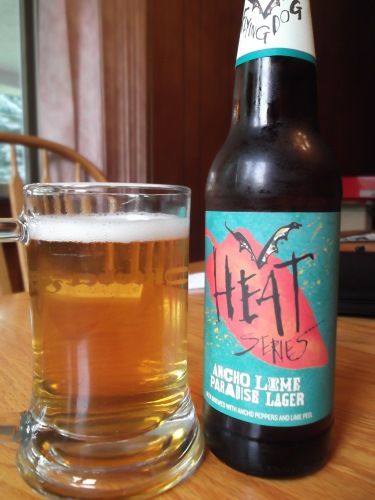
My initial foray into bat country was fruitful. I learned that Flying Dog's founder, George Stranahan, had been friends with Hunter S. Thompson and that Thompson's erstwhile illustrator, Ralph Steadman, has been designing Flying Dog's labels for over 20 years. On top of these revelations, I also discovered a rather tasty summer cerveza teeming with tart citrus and succulent succulence.
The fine folks at the Jenifer Street Market also carry (or carried) Ancho Lime Paradise Lager, a limited edition brew in Flying Dog's Heat series which I presume features beers that challenge drinkers to count Scoville units in addition to, or perhaps instead of, I.B.U.s. I am generally weary of chili beers, I shall admit, as my experiences with them have been hit or miss. Normally consumed at the Great Taste, most have been golden ales laced with enough jalapeño to send me into a capsaicin-induced St. Vitus dance aimed at the water tubs.
And so I was, to be honest, I was a bit leery going in. But I didn't see the words "natural flavoring" anywhere on the label. I am avoiding "natural flavoring" in beer like the Plague these days because I grew tired of naturally flavored fruit beers that taste like candy. Just because a brewer uses "natural flavors" doesn't mean she is adding a few eyedroppers of concentrated ester aldehyde or some such thing. It's just that I've just been burned too much lately with beers that are delectable going by the label but end up being nothing but liquid Jolly Ranchers when actually exposed to the tongue.
I'll also cop to being biased here. When I began drinking microbrews in the first half of the 1990s, the microbrewing industry was growing concomitant to the organic/"natural"/local/slow food movement(s). And so the idea of using, say, fruit flavoring in a beer as opposed to the fruit itself or at least the juice of the fruit just doesn't sit well with me. There are FDA labeling laws to contend with here so it's quite possible that a beer with natural flavoring may simply be laced with some fruit juice.
Besides the absence of "natural flavoring" the label also indicates the presence of Grains of Paradise. Grains of Paradise are the tasty seeds of a particular plant and I like their mellow woody/citrusy/piney kind of taste.
Ancho Lime Paradise is a lovely light gold hue and was clear as day. I got about one inch of loose, white foam atop the brew which lasted a shortish time – maybe 20 seconds. There were lots of bubbles in the beer which topped off the visual bits here and made for a really pretty brew. Flying Dog doesn't say anything about the type of lager that is ALP and instead emphasizes all the ingredients that send Reinheitsgebot purists running to their keyboards to protect Bavaria's virtue. Judging by the fizzy yellowness, ALP radiates New World pale lager.
The ancho is simply a dried poblano chili and it is first and foremost in the aroma. Not that the aroma was particularly pungent. There was also a hint of citrus lurking in the background. On the one hand I was disappointed as one normally likes a food's smell to be fuller to whet the appetite. On the other hand, it could portend a brew where the flavoring wouldn't be overpowering.
It was the lime that I tasted first. Not big but zesty enough. And then there was the earthy and slightly smoky flavor of the chilies. But this was no frisson of fire. Their taste was on the restrained side and there was a little heat at first. Each successive sip, however, kindled the flames so that the burn grew slowly on my tongue. A devious little stratagem on the part of the brewmaster.
And before the capsaicin could reach its crescendo, I was able to catch a light grain flavor.
I was able to discern the Grains of Paradise on the finish where they lingered along with the lime. As those flavors faded, the heat at the back of my mouth became impossible to ignore. There was no lacing left on my glass.
ALP will no doubt be a divisive brew for a majority of drinkers. It has a light body with generous carbonation giving it a nice fizziness. The lime adds a little tang but never gets in the way of anything while the Grains of Paradise complement the citrus well. Those anchos have a nice mellow earthy flavor and I really liked how the heat slowly built up instead of assaulting my tongue right away. As someone who liked spicy foods I felt that it gave a nice burn although folks less acclimated to the heat will no doubt find that it, as Ralph Wiggum famously said, tastes like burning.
Still, I found that one bottle was enough. And not because of the heat.
I didn't dislike ALP but it reinforced my idea that chili beers should go beyond yellow and fizzy. They need more body than ALP offers for repeated drinking, at least at the level of chili flavor here. The flavor of chilies works best for me when it's set against a taste that isn't as sharp, isn't as sprightly.
On a side note, if you go to Flying Dog's ALP webpage, you'll see a photo of a beer that is much darker than what I found in my glass and, well, not yellow. It also lists ALP as being 5.3% A.B.V. whereas my bottle says 6%. It seems as if the brew has been reformulated at some point.
Junk food pairing: Have a bag of Pepperoni Pizza Cracker flavored Combos on hand when drinking Ancho Lime Paradise Lager. While not a very big beer, it is 6% so you'll need a little something in your gut and the creamy pepperoni filling contrasts well against the chili.
No comments:
Post a Comment